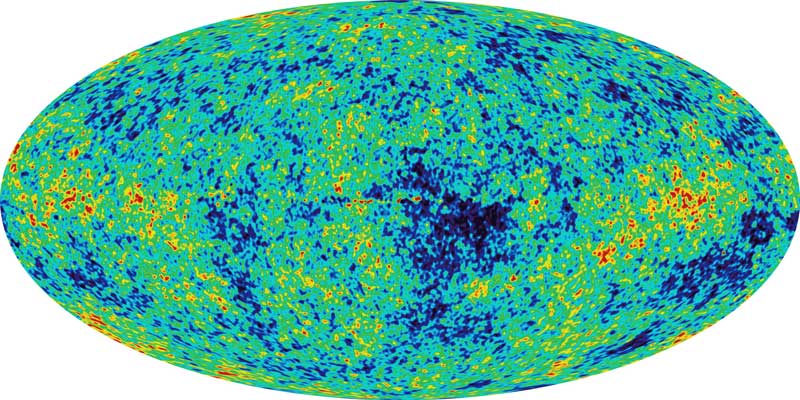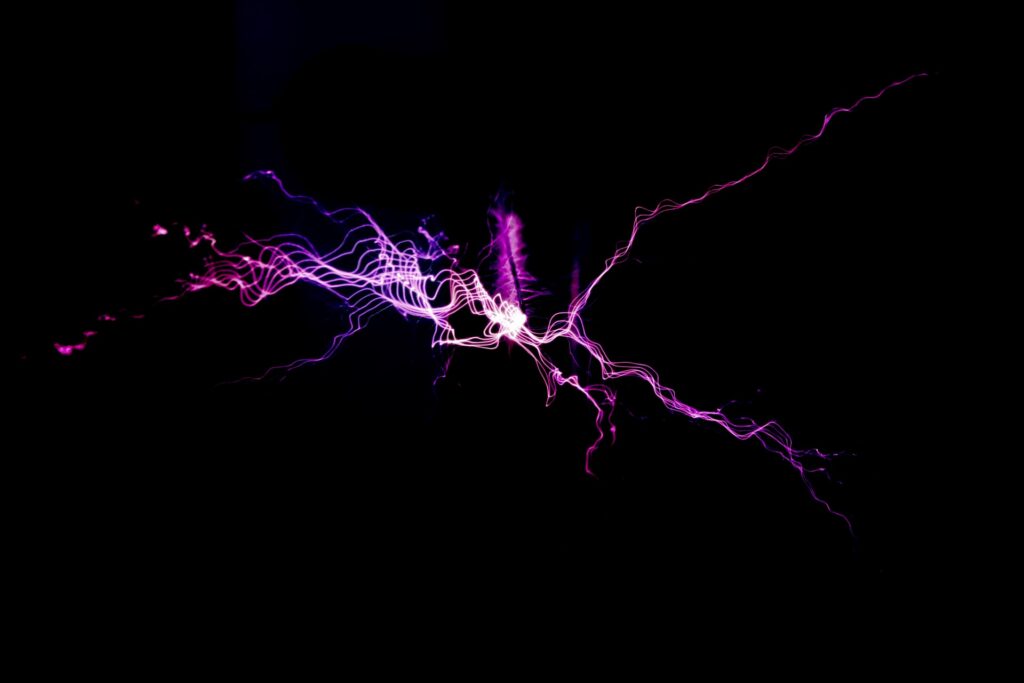The space that we are in, or which constitutes our observable universe, is infinite. But why is there a concept of infinity? Couldn’t there be an end to space?
Space could very well be finite with some edges around it beyond which it should cease to exist. If it has some sort of a shape, such as a convex curvature, it should ideally be bounded by its outermost border, thereby having a limited volume.
The study of Cosmic Microwave Background radiation allows tests of infinite space intuition. Surprisingly, finite models do not fit with the data and all the evidence is against space being finite.

So, there lies something beyond our cosmic horizon, there has to be. An infinity is knocking on the edge of our observable universe, but since our capability to see anything is limited by the speed of light, we cannot, as of now, know what resides in our cosmic neighbor and beyond.
Read our introductory article on Multiverse here.
Level 1 Multiverse: Consequence of Eternal Inflation
From the observations of the three-dimensional galaxy distribution and the microwave background, it is evident that space is infinite with smoothness on a large scale. This uniformity places a constraint – no structures larger than about 10^24 meters. If this pattern goes on, the region outside our observable universe could be full of similar structures – galaxies, stars, and planets.

Pursuing the logic further, we are at the disposal of an infinite number of other universes, and may be, potential of life forming planets. Each individual universe is approximately the same size and contains a similar number of atoms arranged as planets, stars, and galaxies.
Somewhere out there, there could be a copy of all of us. These parallel universes of our other self, account for the Level 1 multiverse. It is the inflationary multiverse produced by eternal inflation.
What is an eternal inflation?
As the cosmos inflate, rather than ending everywhere, individual universes continually crystallize out of inflation. In other words, inflation never stops. This is the concept of eternal inflation.
The eternal inflation causes the region between universes to expand to infinite size and thus no two Level 1 universes can ever interact. Each universe has its own Hubble Volume or the region of space-time.
Observers in parallel universes belonging to Level 1 experience the same laws of physics but different initial conditions than those in our observable universe.
What exactly are the initial conditions?
Initial conditions are the earlier phases of a universe governed by the densities and motions of the various types of matter created by quantum fluctuations. During this period of the inflation epoch (from 10^-36 seconds to about 10^-33 and 10^-32 seconds after the Big Bang), our universe underwent extremely rapid and exponential expansion. After the epoch, the expansion continued but at a relatively slower rate.

As the inflation field decays in different regions, the quantum fluctuations generate random initial conditions with non-zero probability allowed by the quantum laws. The most likely density fluctuations give rise to matter forming clusters which in turn form galaxies, stars, planets, and other structures.
These density fluctuations are described by a term called ergodic random field. Put simply, ergodic means that every possibility that could have happened in one region of space arising out of a non-zero probable case, did indeed happen in some other region of space.
According to a crude estimate, the closest identical copy of you is approximately 10^10^29 meters away, and about 10^10^91 meters away, a sphere of radius ~100 light-years exists similar to the one centered here in our universe.
This also brings us to a compelling philosophical thought – if there are multiple copies of you with identical memories and lives, is there any way to determine which one is the real you as each one of you feel the same?
Unfortunately, there is no way to determine that due to the different initial conditions. A simpler way to understand can be through this – each one of you would have undergone the same physics classes in your schools, but different history lectures. So, your lives will typically begin to take different paths eventually.

Level 2 Multiverse: Bubble universes, a consequence of Chaotic Eternal Inflation
According to Andrei Linde, one of the main proponents of the inflationary universe and eternal inflation theories, the entire Level 1 multiverse has the same kind of elementary particles, identical physical constants, and the same dimensionality.
Space as a whole continues to inflate forever, but in some regions of space, the stretching stops and distinct bubbles emerge, like pockets of flour in a loaf of expanding bread. Over time, many such infinite bubbles emerge. Each bubble is a Level 1 multiverse, infinitely sized, teeming with matter amassed due to the energy field driving the inflation.

The Level 2 multiverse is a consequence of the aforementioned chaotic eternal inflation, according to which the initial state was governed by the chaotic distribution of an inflationary field that showed variation from one region of space to another.
The degree of diversification is much more in a Level 2 multiverse than that of a Level 1. The variation does not happen only in the initial conditions but in other aspects as well. Symmetry breaking takes place in each of the bubble universes, thereby differentiating the bubbles in every facet of nature.
What do you mean by Symmetry breaking?
Symmetry breaking is a concept through which a physical system belonging to a symmetrical state ends up in an asymmetric state. The dimensionality of spacetime, physical constants, and the types of elementary particles are not inherent characteristics of physical laws but are the consequence of processes constituting symmetry breaking.
One way to understand this concept in our part of the universe is that many theoretical physicists think that early space had nine dimensions. Three of them dominated the cosmic expansion and gradually became the three dimensions that govern our reality. This is how the primordial symmetry broke down among the dimensions.

This chaotic state of inflation could cause different symmetry breaking in each of the bubbles, giving birth to numerous universes, individually distinct, each having its own elementary particles, constants of physics, and dimensionality of spacetime.
Each one of these universes can be an embryogenic universe in itself, meaning each can generate other universes leading to a more chaotic and incessant infinity of countless universes as the chain reaction never ends.
According to String Theory, the total number of universes in a Level 2 multiverse is around 10^500, an unfathomable number.
Level 3 Multiverse: Quantum Many Worlds
So far, we have seen the levels of multiverses that are distant enough to be reached. The next level of the multiverse is much closer. It is a consequence of the widely known Many Worlds Interpretation of Quantum Mechanics.
The core idea is that the random quantum processes cause the universe to split into branch universes, each having the possible outcomes which weren’t present in the universe it split from. Quantum Mechanics, in its simplest empirical form, results in a Level 3 multiverse.
Classical world v/s Quantum world
According to classical physics, the state of the universe is determined by the position and velocity of the particles. This understanding of the universe underwent a major overhaul when Quantum Mechanics came along, according to which wavefunction, a mathematical object, determines the universe’s state.
The wavefunction resides and rotates in an abstract infinite dimensional space known as Hilbert space. Whenever someone makes an observation, this wavefunction collapses into a definite classical outcome.
Later on, as proposed by Hugh Everett III, the collapse of a wavefunction did not fall into a necessary event to happen. Rather, it is predicted that a classical reality splits into a superposition of many such realities. This superposition of classical worlds is the Level 3 multiverse.
A Quantum Die Analogy
To understand this concept better, let’s assume we have an ideal die whose randomness is purely quantum. When you roll it, you see a definite outcome, completely random. If viewed from a Quantum Mechanics perspective, the die generated all the possible outcomes at once. It landed on all the values in different universes. Since we are bounded by the limits of our universe, we fail to perceive the quantum reality in totality, we are but a spectator to only a fractional value.

According to the Many Worlds Interpretation (MWI), there is only one wavefunction of the entire universe. It is objectively real and does not collapse. It results in every possible outcome occurring in separate universes or alternate realities. The over-arching situation can be thought of as a multi-branch structure, a superposition of the entire universe that describes the system of such disconnected universes.
Everything that can be attributed to having an occurrence, and according to Quantum Physics has a non-zero probability of happening, is being realized in its own disparate reality all the time. So, MWI states that every single quantum event leads to many universes.
One logical and still controversial inference leading to us being quantum follows from the atomic realm. As we are made of atoms and if atoms can be in two places at once in a superposition, so can the sum together of the parts, i.e., we can also be in a superposition.
Although the Level 3 multiverse does not add significant new layers to the Level 1 and Level 2 multiverses apart from creating identical copies of the same universes, the implications are immensely deep and philosophical.
Imagine taking a life decision the other way around, imagine our Sun being replaced by a relatively larger or smaller star, imagine you having family members other than you currently have, and so on.
The quantum realm explores every possible version of itself that doesn’t violate the fundamental physical laws and embraces every plausible version of reality no matter how minute the differences or variations between these realities are.
Level 4: Mathematical Universe & Mathematical Structures
All the earlier levels differ from each other on the scale of initial conditions or physical constants, but they all have one thing in common – the underlying fundamental laws that govern them.
According to the Mathematical Universe Hypothesis, there can be a universe that obeys classical physics laws but is devoid of any quantum presence, there can be another universe where time exists as a discrete entity rather than being continuous. A Level 4 multiverse allows every such alternative reality to exist.
Such universes can have different physical laws, mathematical equations, and even different notion of a physical existence. In fact, our physical existence is a mathematical structure, not just described by mathematics, but is mathematics in its truest form.
What is a Mathematical Structure?
A mathematical structure is an abstract, entrenched entity that lies outside of space and time. It points to an ultimate language or notion that describes the universe independent of any semantics known, invented, or discovered by humans.
A pure mathematical structure has underlying fabric, patterns, or properties of a mathematical concept which is not dependent on any real-world object.
Whether it is humans, a super-intelligent computer, an AI, or an alien, the structure needed to describe the universe can be comprehendible to each of them. Mathematical structures are not invented, they are discovered; and we invent notations to describe them.

Arising out of many reasons for us to not yet know in what mathematical structure our universe resides, it is equally challenging for us to know which close candidate to the theory of everything – String Theory or Loop Quantum Gravity does our universe correspond to. Or there can be an altogether different theory which we are yet to come up with, or maybe we won’t ever be able to do that.
The fundamental description of the universe is mathematics. Rather than the evident case of mathematics approximating physics in all the physical laws, it is, in fact, mathematics approximating mathematics all the way.
Mathematical Universe Hypothesis at its most extreme offers the Level 4 multiverse within which every universe is a mathematical structure containing all the other levels within it.
According to Max Tegmark, an isomorphism exists between an entity and its mathematical structure. At an elementary level, they are actually the same thing. He offers two different views of the universe – the bird perspective and the frog perspective.
The bird perspective corresponds to an outside view of the universe, like a mathematician studying the mathematical structure. The frog perspective is the inside view, referring to an observer living within the structure.
When you observe the universe through a bird’s perspective, you see the mathematical structure and its sub-structure (like a tree or a human). A substructure like human has a unique property of consciousness – the frog’s perspective. This is the reason why we humans perceive the universe being physically real. On the other hand, other sub-structures are relatively simple to have a frog’s perspective.

Physical existence is something that emerges in some mathematical structures. From a bird’s perspective, physical existence is a tag used by a bird, similar to a mathematician using it to distinguish between structures that have self-aware sub-structures and the ones that don’t. A frog’s perspective is what makes the structure physically real.
A fundamental asymmetry appears in all the preceding levels. The Mathematical Universe Hypothesis, on the other hand, proposes an entire mathematical symmetry that allows all the mathematical structures to have physical realities.
The subjective experience of the physical existence is realized only in the mathematical structures or the level 4 universes that in their very heart, are complex enough to allow the existence of self-aware and conscious intelligent beings. Every mathematical structure corresponds to a universe in Level 4 multiverse.
Conclusion: Simplicity at the heart of Multiverse
If we closely analyze the different levels of the multiverse, it is quite evident that the higher-level multiverses are simpler. Transitioning from our universe to a Level 1 universe removes the need to specify initial conditions, moving up to the Level 2 multiverse eradicates the need for physical constants, and the Level 4 multiverse eliminates the need to enumerate anything at all.

These multiverses should exist, denying their existence would lead to the violation of the first principles itself – such as finite space and no large-scale smoothness in the cosmic microwave background data, non fine-tuned parameters instead of fine-tuned ones, and wave function collapse to name a few.
It’s just that at this point in space and time, we do not have all the resources or the intellectual capability to understand the truest form of reality. Whenever that happens, nature will lay out all the different layers for us to be in her awe.
If not, irrespective of human’s non-existence in the far future of the cosmos, there would be some entity, a higher dimensional may be, who would have finally unlocked the mystery.


Maybe it’s like that. However, only from the perspective of an observer who is able to analyze, compare and represent only on the basis of the opportunities provided to him. Observers of a different type and level may see things differently. Of course, the universe, no matter how big it is based on our vision capabilities, is finite. Outside the universe, there would seem to be an infinite void – but it only seems to us. It’s just that we are not able not only to see such supergiant spaces, but also to imagine its size and shape. Professor Felix I. Sharkov
Возможно все так. Однако только с позиций наблюдателя, способного анализировать, сопоставлять и представлять лишь исходя из предоставленных ему возможностей. Другого типа и уровня наблюдатели могут видеть все иначе. Конечно же Вселенная, какой большой бы она исходя из наших возможностей видения ни была, – она конечна. За пределами вселенной казалась бы бесконечная пустота – но это только нам кажется. Просто мы не в состоянии не только видеть такие сверхгигантские пространства, но и представит ее размеры и формы. Профессор Феликс И. Шарков